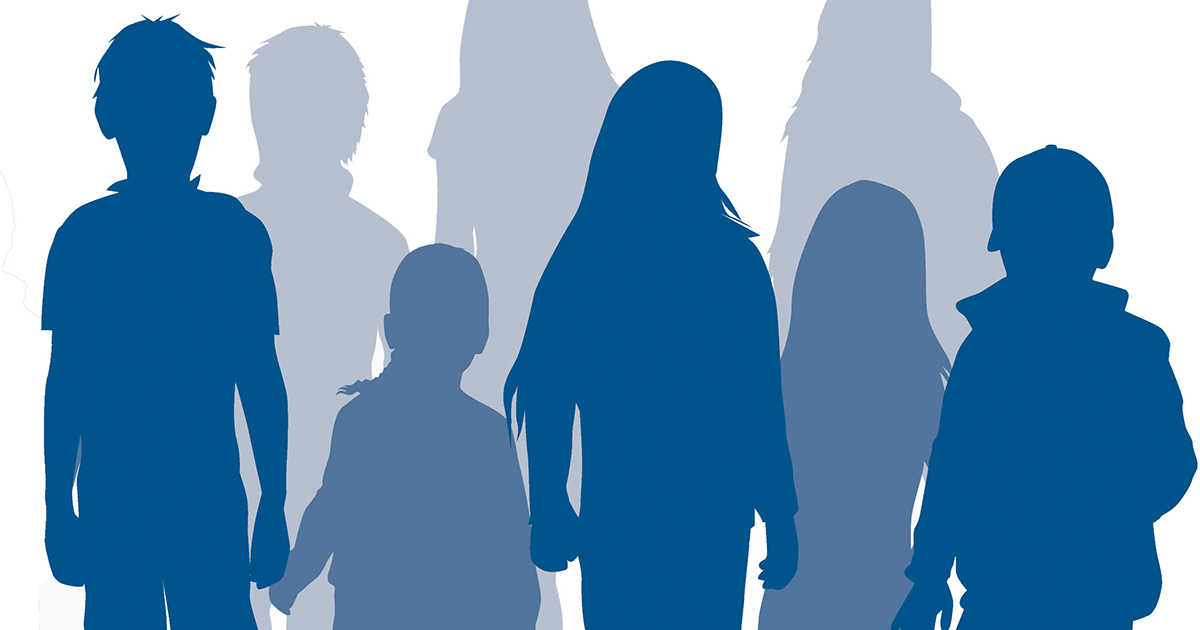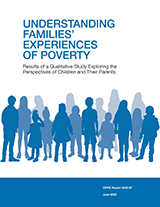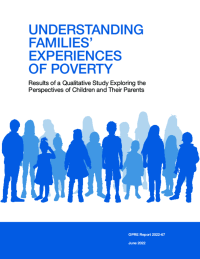Understanding Families’ Experiences of Poverty
Results of a Qualitative Study Exploring the Perspectives of Children and Their Parents

Introduction
 In 2019, when data collection for the Childhood and Family Experiences Study began, approximately 10.5 million children—about one out of every seven children—in the United States lived in families that were experiencing poverty. Considerable research evidence links childhood experiences of poverty to harmful effects on physical and mental health, social and behavioral functioning, and cognitive, academic, and educational outcomes. Yet little is known about how children and their parents view their daily experiences of living in poverty and their interactions with social safety net programs, or how they perceive wealth, poverty, and economic inequality.
In 2019, when data collection for the Childhood and Family Experiences Study began, approximately 10.5 million children—about one out of every seven children—in the United States lived in families that were experiencing poverty. Considerable research evidence links childhood experiences of poverty to harmful effects on physical and mental health, social and behavioral functioning, and cognitive, academic, and educational outcomes. Yet little is known about how children and their parents view their daily experiences of living in poverty and their interactions with social safety net programs, or how they perceive wealth, poverty, and economic inequality.
To address this gap, the Office of Planning, Research, and Evaluation in the Administration for Children and Families (ACF), U.S. Department of Health and Human Services, contracted with MEF Associates to study the perspectives of children and their parents who experience poverty. MDRC, a subcontractor to MEF, conducted the study in partnership with MEF.
Primary Research Questions
- How do parents and their families interact with public assistance offices and workers, and what is the experience like for them?
- How do families talk about public assistance benefits such as Temporary Assistance for Needy Families (TANF) benefits?
- What do parents think about how their economic circumstances and receipt of benefits affect their families and children?
- What do children understand about their families’ economic circumstances?
Purpose
The Childhood and Family Experiences Study seeks to understand how children, adolescents, and parents perceive and experience poverty. Because ACF administers social safety net programs, such as TANF, it seeks to better understand the experiences of families who participate in these programs and receive services. It is also interested in learning more about the perspectives of those who may be eligible for services but do not receive them.
Key Findings and Highlights
- Parents valued and recognized the important role that public assistance benefits played in easing their family’s experiences of material hardship. Families relied on a mix of public assistance programs, especially the Supplemental Nutrition Assistance Program (SNAP) and Medicaid. Parents reported both value and drawbacks to participating in public assistance programs. They described mostly positive interactions with program staff members, were grateful to receive benefits, and saw the benefits as essential to meeting their family’s needs. However, they were aware of the stigma that is associated with these programs, and some felt uncomfortable receiving benefits.
- Children’s and adolescents’ understanding of the benefits the family received was limited, except for SNAP benefits. Both children and adolescents knew that their family received food assistance from SNAP. But they were less familiar with other public assistance programs, especially TANF. Older children and adolescents were able to explain SNAP in greater detail than younger children and understood that SNAP is a government-sponsored food program to assist families in need.
- Parents worried about but were resourceful in dealing with economic hardship. They placed a priority on basic needs such as rent and food, and tried to meet their children’s needs and wants. They considered carefully when, how, and what to share with their children about their family’s economic circumstances. Parents tried to shield their children from their financial worries and difficulties, but they were more forthcoming with their adolescent children. They tried to help their children understand the importance of prioritizing needs over wants.
- Children and adolescents were aware that their families struggled financially and could not always afford to meet all of their needs and wants. They knew that their parents worried about finances, but they did not describe their families as being “poor.” Instead, children and adolescents would say that they were “doing okay.” Children and adolescents, but especially adolescents, understood the need to place a priority on needs over wants and to delay purchases.
- Children and adolescents described poverty as having few material possessions and difficult circumstances, but they did not refer to their own circumstances when describing what it means to be poor. They described wealth as an abundance of material possessions and access to resources and opportunities, and the middle class as “normal.” Children, more so than adolescents, said that economic inequality is unfair. Both children and adolescents mentioned that wealthier families and the government should help those who are less well-off.
Methods
The research team used qualitative research methods to elicit the perspectives of parents and their children ages 7 to 17 in three communities located in urban and rural areas in the United States. The team conducted in-person, semi-structured interviews with at least one child and one parent in 30 families from July 2019 through January 2020.
The research team analyzed interview transcript data and identified themes that are relevant to the four research questions. It is not possible, or appropriate, to apply findings from the study to the larger population of families in poverty in the United States.
This report analyzes data from interviews that were conducted with families in 2019 and early in 2020, before the onset of the COVID-19 pandemic that affected daily life, work, and school beginning in spring 2020. In fall 2020, the research team returned to interview nine parents—three in each of the three communities—to understand how the pandemic had affected their families. A separate brief based on these nine follow-up interviews builds on findings presented in the current report and is available on the OPRE website for the project.







